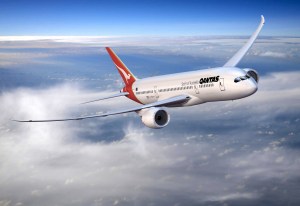
AP
I was on a Qantas flight in eastern Australia last week when a flight attendant handed me what looked like a fancy barf bag. It was, in fact, not a fancy barf bag, but a fancy recycling bag, in which I was instructed to place everything that was not a can, plastic cup or a bottle. The idea is that the flight attendants collect and sort out your recyclable items, and you, the passenger, fill up and hand over your bag of non-recyclables for the crew to throw out.
I hate to be a spoilsport here. But. Obviously, the scheme has good intentions. Qantas launched its onboard recycling program last December on selected domestic flights in an effort to reduce its waste reduction to landfills 25% by 2011.
But why the paper bag, Qantas? Though the airline’s cups are apparently 35% recycled paper, the recycling bag itself was not marked in anyway to indicate that it was made out of post-consumer waste. So I have to wonder what the logic is in creating more trash to sort your trash. Sure, it means the flight attendants don’t have to run down the aisles with a bag collecting apple cores, soggy tissues other gross passenger detritus. If I was a flight attendant, I would prefer to collect neat bags of trash from my sloppy charges too. Makes sense as a labor initiative, or as a time-saving initiative, but as a recycling initiative? I dunno.
(Also, why bother when you’re handing out lilliputian individual bottles of water that contain about a shot of hydration each?)
Not surprisingly, I am not the first person to complain about inflight waste management. In February, a report released by Green America slammed the U.S. airline industry for their overall lack of initiative on the matter. The report, which estimates each passenger generates about 1.3 pounds of waste per flight, says U.S. airlines could be recycling up to 75% of onboard waste, compared to the 20% that is recycled today. Though all the airlines evaluated in “What Goes Up Must Come Down” acknowledge that it’s important to recycle their flights’ waste, none have programs that cover all inflight waste — including paper, plastic, aluminum and glass — and none tackle composting of food waste. (Come on, RB, if anyone could pull that off, you could. Get Jamie Oliver in there.)
Here’s the best-to-worst list of airlines’ recycling programs, according to Green America’s research:
- Delta Airlines
- Virgin America
- Virgin Atlantic
- Southwest Airlines
- Continental Airlines
- Jet Blue
- American Airlines
- British Airways
- Air Tran
- United Airlines
- US Airways
Oh, United. We know you’re hurting, but aren’t you just a little too big to be so low on that list? Here’s what that company’s web site has to say about it’s onboard recycling program:
As a first step, we recycle all aluminum and plastic beverage containers from domestic flights that arrive in Hawaii. Next, we will be expanding our program to arrivals at other locations, such as Los Angeles, San Francisco, and Seattle-Tacoma airports. The expanded program takes into account the complexities associated with the requirements, processes, and opportunities associated with each airport. We look forward to expanding our onboard recycling program.
Pretty weak. Other airlines seem to be more committed to the cause — at least on (interweb) paper. Though it ranked low on Green America’s list, British Airways‘ is at least thinking big: Their goal is to reduce waste to U.K. landfills to zero by 2010. (Not sure how that’s possible or whether its been accomplished, but that’s the goal.) Cathay Pacific, for its part, launched an onboard recycling program way back in 2006.
Airlines, obviously, have a lot of cleaning up to do, and the race to come up with a truly greener way to fly has really only just started. In the meantime, it seems like it’s pretty easy for these big polluters to clean up their acts with existing technology and a little extra elbow grease from the air and ground crews. I like the idea of involving the passenger in the process. Japan’s All Nippon Airways, for instance, at one time was encouraging passengers to use the bathroom before they board as to reduce weight and fuel use. Creative! I, for one, am happy to do my part, whether that means boarding with an empty bladder, or picking through trash on my tray. There are, after all, only so many episodes of 30 Rock a person can watch at 36,000 feet. It’s a welcome distraction.
Do I need a separate paper bag to do it? Not so much. If fact, I kind of doubt we still need all those barf bags. But better safe than sorry.


